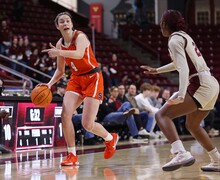Red-tailed hawks Otto, SU-Sue found the hearts of locals
Courtesy of Anne Marie Higgins
A nest camera was installed to document the lives of SU-Sue and Otto, the two red-tailed hawks who called Syracuse University their home.
Get the latest Syracuse news delivered right to your inbox.
Subscribe to our newsletter here.
For 11 years, Syracuse University’s mascot was not the only Otto on campus. Since 2012, two red-tailed hawks, Otto and SU-Sue, called SU their home as they nested on various buildings throughout campus. Otto died last week, just five days after SU-Sue’s death.
“So many people have said that they never realized how amazingly devoted a pair of hawks can be to each other and to their chicks,” said Anne Marie Higgins, a bird enthusiast and SU alumna. “They taught us things that some people just never realized about hawks.”
In 2017, SU installed a nest camera to broadcast the birds and their daily lives. The camera was funded through a donation from Higgins, an alumna, which she dedicated in memory of her husband. Higgins also organized a Facebook page in 2019, Red-Tailed Hawk Tales, which offered enthusiasts photos and updates on the hawks.
Through the nest camera, viewers enjoyed learning that red-tailed hawks mate for life, Higgins said. Higgins added that the pair made “hawk-a-holics” out of many people.
Kellie Suzanne Paquette, a member of the Facebook page, added that people were not only observers of the hawks, but also students.
“The relationship that developed, over time, between any of us watching, and this beautiful pair was incredible,” Paquette said.
SU-Sue died on Jan. 14, and Higgins said that she and others were hopeful Otto would be able to find a new mate and continue to nest on campus. But when she got a call on Jan. 19 that another deceased hawk was found on campus, Higgins said the news was heartbreaking for many and that she was especially devastated.
Yet, Professor David Althoff, who specializes in biology and ecology, thinks there may be hope for the “hawk-a-holic” community. He thinks another nesting pair may soon move into the territory SU-Sue and Otto previously occupied.
During their time on campus, SU-Sue and Otto hatched 28 offspring. Not all 28 are still alive, but Dr. Althoff says it could be possible that the young come back to claim the territory of their parents, though offspring typically seek out their own space. Paquette expressed how being able to watch this nesting and growth process was truly special.
“I marveled at how they instinctively knew how to tend to all the nesting requirements, to the sitting on the eggs to the feeding times,” said Paquette. “I kept going back and drawing the parallel to us, to humans and their babies.”
SU-Sue and Otto died from the Avian Flu, according to the Facebook page. Cornell University’s Animal Health Diagnostic Center confirmed that both birds were positive for the flu, the post read.
Paquette said she hadn’t expected the pair to die in this way or so quickly. When she heard the news, she immediately messaged Higgins.
“My heart came into my throat. I cried,” Paquette said. “We chatted back and forth about this incredible loss.”
Many members of the Facebook group shared similar sentiments, with hundreds of comments on the posts commemorating the hawks and expressing their sadness on the news.
Paquette said both she and Higgins had deep connections with the hawks. Paquette said when she feels confused or scared, she sees the hawks as a visit from her dead father, calming her down.
“(The hawks) were angels when they were upon this earth and now, they are angels in heaven,” Paquette said.
Published on January 30, 2023 at 10:35 pm






